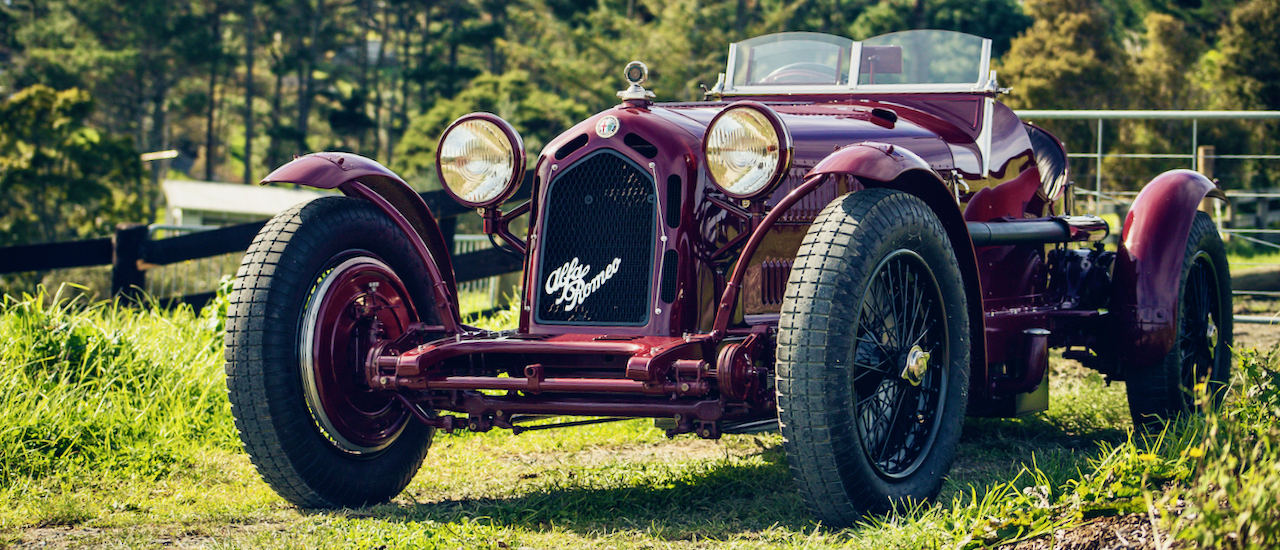
Replica Alfa Romeos
Chris van Ryn talks to a talented builder of bespoke Alfa Romeo replica racing cars.
In a barn-like workshop on the fringe of Auckland, Colin Howard and assistant Gavin Tindell are conjuring up a 90 year-old vehicle.

The workshop contains a concentrated air of ingenuity, perseverance and achievement. It arises from decades of investigation – and a commitment to an unwavering passion: to create a replica so exact as to be indistinguishable from the original. The vehicle that emerges is built to original standards and blueprints, using authentic manufacturing techniques.
Tacked to the back of the workshop’s roller doors are large prints of the original drawings. A partially composed skeleton raised by jacks crouches on the pale concrete floor. Attached to its battleship grey frame are four glossy-black spoke wheels. At the front is a brass radiator with a small disc mounted vertically on top - on one side, an emblem of a man carrying a child – St Christopher – and on the other, a curious looking 'scientific instrument’ that reveals itself to be a thermometer.
And then there is the tiny, almost indecipherable logo, embossed in the base of the steel disc. True to the original. When the conjuring is complete, some 4,500 components and 14 months later, the result is a hand-crafted 1931 Alfa Romeo Monza replica – an afficanado’s dream racing car. With its eight-cylinder engine clipped to a lightweight chassis, Italian engineer Vittorio Jano's creation became a racing legend in the early 1930s. Only 188 were ever made.
“Building replica vehicles has become widely accepted,” says Colin. Today, replicas, when commissioned by Jaguar or Aston Martin, are referred to as ‘Continuation Cars.’ In recent years, original, historically important cars have skyrocketed in price. One Alfa Romeo Monza recently sold for $12 million.
Colin did an apprenticeship as a mechanic with a Ford dealer out in West Auckland. But it was while working with McLaren Cars that he got a buzz for restoration.
“I went to the UK, and found a job with a guy who restored Alfa Romeos. I went for a drive in a 1931 Monza one cold winter’s morning and we did 120 miles per hour (190km) up the bypass. I was hooked.”
Colin's plan was audacious, to say the least. He flew to America, where a car had been completely disassembled, took photos and drew and measured each component before heading home and transferring the sketches to the drawing board. Later, he attended design school, where he learnt the power of CAD (computer aided design) and 3D modelling.

Twelve years ago, Colin assembled his first Monza. Since then, his workshop has produced six Monzas and three Corto Spiders. Once the coachwork is complete, the vehicle is shipped offshore, where the customer procures and installs the engine. Colin's clients reside mostly in the UK and commissions are through word of mouth.
What makes a continuation car indistinguishable from an original? Much of it is in the ‘hidden’ detail: the precise placement of a rivet in the chassis, the burr and grooves on an axle from a casting, a small embedded logo in a discrete location.
“See this?” Colin leans over, and, with reverence, places a shackle pin on an anvil as if it were an altar. The shackle pin is made from alloy and has intertwining helix groves running along its shaft and a brass grease nipple. “Beautiful, isn't it? The way the helix allows oil to travel down the grooves.”
Many of the components are handmade, turned, cast or beaten with a hammer. There are parallels with sculpture: an understanding of metallurgy, hand-shaping, forging and casting. “Apart from a few minor details – the steering wheel is made of urethane and not Bakelite, for example,” says Colin, “it’s exactly the way they made these vehicles back in the day.”
It's this love of detail and process which infuses an Alfa Romeo Monza continuation car by Colin Howard with its own narrative. Everything has to be just right: the artistry, the engineering, the harmony of form. The end result retains the authentic ‘voice’ of the original Monza but also bears the subtle fingerprint of its maker. And in this way, a Colin Howard replica establishes a provenance that has mana in its own right.
Read more from this AA Directions issue while you're here:
Reported by Chris van Ryn for our Autumn 2023 issue